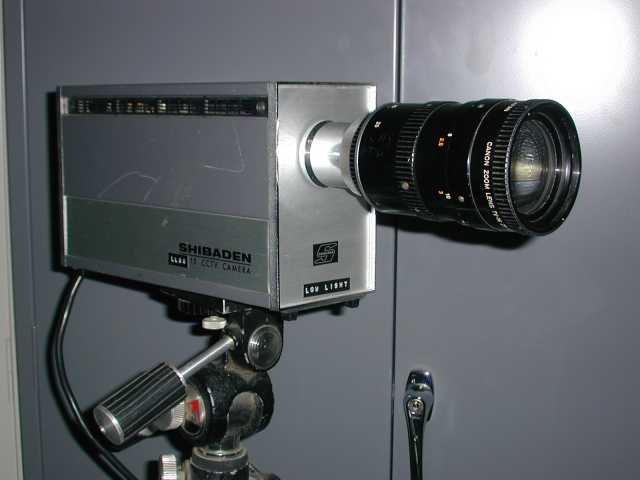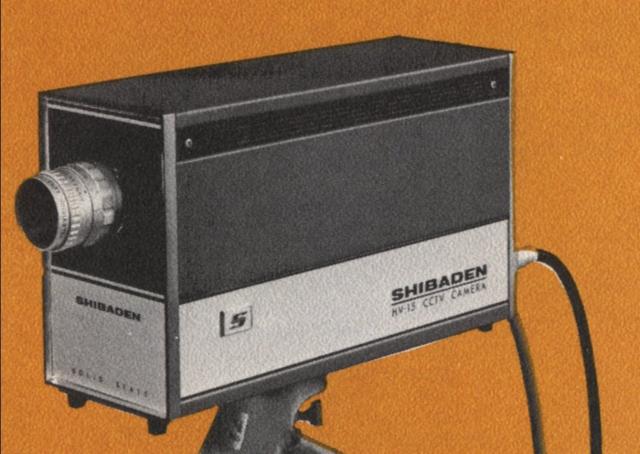LabGuy's World: 1970 Shibaden
LLSA-15 (HV-15) Low Light 1" Vidicon Camera
New Addition! 01.03.16:
New Information! 02.08.04:
  
1970 Shibaden LLSA-15 (HV-15) Low Light
1" Vidicon Camera
.
I have
very little information on this one, other than it's rather large and heavy.
The LLSA-15 uses a 1", high sensitivity, vidicon or saticon tube. It is
a customized version of the more mundane Shibaden HV-15, 1" vidicon camera.
A very high quality unit and in excellent condition, too. The lens, shown
in the first two photos, is one of my spares. It's a monster! A Fujinon
14 mm - 70 mm, f 2 zoom lens. This is the only lens I have for 1" tube
cameras. External controls for Channel (2-6 VHF) set, ALC set, Beam, Electronic
Focus and Mechanical Focus. One jack for either Video output or RF output
for use with a regular TV set.
From the
Shibaden 1969? Catalog: The model HV-15U is a high quality moderately priced
vidicon television camera utilizing specially selected silicon transistors
for compactness and superior picture pick up capabilities. It is ideally
sized and priced for budget minded educational institutions, government
agencies and small businesses for use in an almost unlimited variety of
CCTV and video tape recording situations. The model HV-15U accepts any
standard "C" mount lens. With a video standard resolution of 650 lines
and a built in Automatic Light Control circuit, this camera offers better
reproduction, more versatility and longer service life than many of the
larger, higher priced vidicon television cameras on the market. This camera
is also available with a crystal controlled oscillator circuit to simulate
the stability and other advantages inherent in a 2:1 interlaced camera.
(Specify HV-15C) For 2:1 interlace, specify HV-15S. [CLICK
HERE] to read the features and specifications of the HV-15.
.
NEEDED:
Service manual, operator's manual.
.
Update! 03.06.05
(First Draft)
.
Bob Bruhns
wrote to me recently with some great historical information. Here is what
he had to say:
The LLSA-15 was a silicon target camera based on the Shibaden HV-15.
It was made (retrofitted and modified, really) by a company called Impossible
Electronic Techniques, Inc. at 121 Pennsylvania Avenue in Wayne, PA back
in the 70s.
Impossible
Electronic Techniques (IET) was the brainchild of Jesse C. Wagner, and
was founded by Jesse and his dad Charlie Wagner, of Wagner Engineering,
121 Coulter Ave., Ardmore PA. Jesse was working as a salesman
for Shibaden America, and he was a follower of the Apollo space and moon
missions. When a camera in one of these missions panned across the
sun and ruined the vidicon tube, he understood the situation. But
when silicon target technology solved that problem and several others as
well, he really took notice. When silicon target technology was released
through RCA in Lancaster, PA, he went to Shibaden management and asked
if they would market a silicon target camera. They said no, they
were happy with the antimony tri-sulphide technology of the time, a workable
but not-so-sensitive solution. Jesse asked if they would mind if
he left the company, bought HV-15 cameras, and retrofitted silicon target
tubes. Shibaden said no problem, it would be a higher price, higher performance
market, and they weren't interested. So, IET was born, some time
around 1971.
I came
on board at IET in April of 1972. I had known Jesse from ham radio
in the late 60s, and I was out of work, so he said come on down!
I started out installing the existing mods to the HV-15. These were
mostly gain adjustments. We added extra video gain, but it added
complexity to the design. Later we improved the high frequency peaking
to take advantage of the sharpness of the high quality Canon and Wallensak
lenses (Wallensak was
bought out by Lenzar of Winter Park Florida at that
time), and the 700 line resolution of the RCA 4532 1" silicon target tubes
we were using. The HV-15 was a really well designed camera, the RCA
4532 was a great silicon target tube, and so our LLSA-15 versions stood
up to the vibration and temperature extremes in venturi-cooled enclosures
in US Steel's furnaces. The only real flaw in the LLSA-15 was that
it did not have "gamma" correction. This caused poor contrast
in the shaded areas of the image. The main strength of the LLSA-15
was the "floating" white clipper. Because we ran out of video
gain in really dim scenes, we set up the white clipper with a floating
clipping level (really a diode to a resistor and capacitor in parallel
to ground. At night, the video level was lower, so the capacitor
voltage was lower, and the clipping level was lower. The user just
turned up the monitor contrast, and the image had good highlight control;
this actually worked quite well. A more sophisticated fixed clip level
design would have lost the highlight control without heavy video auto-gain
increase, which was beyond our technology at the time.
Suddenly
in about 1974, Hitachi-Shibaden announced that the HV-15 was to be discontinued.
They offered the HV-16, I think, but it was designed such that it would
be hard to modify as we had been doing with the HV-15. So, IET switched
to the Telemation 1" silicon target camera as a base camera for fine-tuning
modifications. Telemation (Salt Lake City, Utah) made a nice
camera, but it had a couple of design errors that were easily fixed.
We modified the Telemation fixed-level white clipper to act as a floating
white clipper, and this worked quite well. The Telemation camera
had significant video auto-gain control range, and the floating clipper
extended the usable light range nicely. We soon discovered that it
was useful to decrease video bandwidth when video gain was really pushed;
the overall result was a more visible image. A significant feature
of the Telemation camera was that it offered
"gamma" correction. It was only a one-diode "single-break"
correction, but it really made the image more watchable!
IET also
had a low-cost 2/3" silicon target tube camera (which used the RCA 4833
tube). This camera was known as the LSD500. This camera was
also based on a Hitachi-Shibaden camera, I forget which one.
The silicon
target vidicon cameras had two very-low-light brothers: the SIT and ISIT
versions. I forget the model designations for these. The early SIT
and ISIT had longer cases specially made by Shibaden to enclose the |
single-intensified SIT and the
double-intensified ISIT. The SIT had a blue-peaked phosphor, but
it's high sensitivity and the slight IR extension of the phosphor made
it more sensitive than a silicon-target tube camera with IR lighting.
The ISIT had a seriously extended IR response phosphor, and it was a true
starlight camera. Pitch dark to the eye produced a snowy 20-30 dB
S/N image from the ISIT. An IR light would really light up a scene.
And with a Questar telescope lens, it was amazing what could be seen!
We had similar extended cases made by Telemation for the later SIT and
ISIT we built based on their camera design.
In the
early 1970s, a Dr. Topp in Texas was experimenting with the ISIT for evaluation
of the image appearing on the retina of patient's eyes. For this
application, he wanted unity gamma, so the HV-15 based camera worked
well for him. Around 1976, a local experimenter was building a
bottle inspection camera system using a silicon target tube camera, and
he also wanted unity gamma. We were using the Telemation camera,
and it was
strappable for unity gamma, so that's what we did.
In the
video industry at that time, most video benches were equipped with a "light
box" illuminating a gel transparency resolution test pattern. Then
the camera was set up with a lens of known focal length at a standard distance,
and we would adjust the height and width settings of the camera sweep and
check the camera resolution, gray scale, etc. The light box was illuminated
by an incandescent lamp on a dimmer. IET later
bought an "Optoliner", a high-precision unit that
screwed directly into the "C" mount of the camera. The Optoliner
was a much more precise resolution pattern source, and it was closely calibrated
in light level as well. Finally we could really specify camera
sensitivity in strict scientific terms.
Dr. Topp
noticed an interesting thing with his ISIT. Using his light box and
test pattern gel filter, the gray scale appeared to have seriously non-linear
response, a very high gamma. He needed the specified near-unity gamma
(0.95 spec from RCA), and here we seemed to be giving him major heartburn!
I tried this on my own setup, with similar results. How could this
be? RCA specified the tube, and they were rock solid on such things.
At some
point during this test, I happened to change the dimmer setting in the
light box. The gamma curve appeared to change! This made me
think about the spectrum of the light from the dim incandescent, and the
extended red photocathode of the ISIT, and the spectral response of the
gel filter resolution pattern. And that was it; the gel was not "neutral
density" (flat spectral attenuation) in the near infra-red! Because
of this, the attenuation of the gel filter as seen by the camera depended
on the spectrum of the light and the spectral response of the camera, and
the normally even gray scale steps could really get messed up. And
this effect was in turn affected by the color temperature of the light
source. This would never have been an issue with antimony tri-sulphide
technology, but it certainly affected IR-responsive cameras. A fluorescent
light in the light box would solve the problem, but
we were all satisfied just to know what the problem
was.
We didn't
measure the gamma, we just looked at scenes and judged the quality by eye.
You could really tell the difference between gamma corrected and unity
gamma settings! Everybody was happy.
IET sold
a lot of ISIT cameras in 1974 when the permissible radiation level used
in airport X-ray machines was severely reduced. The screens were
too dim for anything but an intensified camera, and the high resolution
of the silicon intensifier technology made the ISIT the technology of choice.
Jesse had
really wanted the company name to be Impossible Electronics, but someone
in Los Angeles area had trademarked that name. We answered the phone,
"This is Impossible!" This was amusing, because many of our customers
were serious federal agencies such as the FBI, etc. Then again, their
purchasing agents used assumed names such as Carlos Castanada, etc.
Also, our business cards showed a flying saucer logo.
It happened
that there was a scene in the old Star Trek TV series, where Spock said
"This is impossible," and we always wanted to put a recording of that on
an answering machine, but it never happened. |
[HOME]......[MUSEUM
OF EXTINCT VIDEO CAMERAS]
Last updated: January 06, 2005 |


